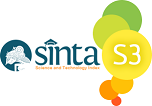PERANAN MIKROORGANISME ENDOFIT DALAM DUNIA KESEHATAN: KAJIAN PUSTAKA
DOI:
https://doi.org/10.31851/sainmatika.v16i1.2695Keywords:
bioactive, compound, endophytic, plant, medicinallyAbstract
The infection disease is still important problem in Indonesia, especially in eastern part of Indonesia. The problem of the bacterial resistance has resulted in increased morbidity, mortality, and costs of healthcare. This situation is therefore drives many researches on discovery for new antibiotics and novel bioactive compounds to combat multidrug resistant microbes, such as Mycobacterium tuberculosis, Staphylococcus spp., and Streptococcus spp. Â The aim of this study is to know the development of the endophytic microorganisms. The endophytic bacteria provide vast potential in producing various novel natural products, including secondary metabolites similar to their hosts. The plant is one of host for the endophytic microorganisms reside. In Indonesia, that endophytic is used medicinally for treatment as well as from the host. The bioactive compound of endophytic microorganisms are used medicinally for treatment antibacterial, antiviral, anticancer, antioxidants, antidiabetic, and immunosuppressive. These showed that endophytic bacteria are promising source of new antibiotics against susceptible and resistant forms of various infectious microbes.
References
Bai, Y., Aoust, F., Smith, D., & Driscoll, B. (2002). Isolation of plant-growth-promoting Bacillus strains from soybean root nodules. Can J Microbiol, 48, 230-238.
Ballio, A., Bossa, F., DiGiogio, P., Ferranti, P., Paci, M., Pucci, P., Scaloni, A., Segre, A., & Strobel, G.A. (1994). Structure of the pseudomycins, new lipodepsipeptides produced by Pseudomonas syringae MSU 16H. FEBS Lett., 355, 96-100.
Bensky, D., & Gamble, A. (1993). Chinese herbal medicine. Materia medica, new ed. Eastland Press Inc., Seattle, Wash.
Bouarab, K., Potin, P., Correa, J., & Kloareg, B. (1999). Sulfated oligosaccharides mediate the interaction between a marine red alga and its green algal pathogenic endophyte. Plant Cell, 11, 1635-1650.
Brady, S.F., & Clardy, J. (2000). CR377, a new pentaketide antifungal agent isolated from an endophytic fungus. J. Nat. Prod., 63, 1447-1448.
Castillo, U., Harper, J.K., Strobel, G.A., Sears, J., Alexi, K., Ford, E., Lin, J., Hunter, M., Maranta, M., Ge, H., Yaver, D., Jensen, J.B., Porter, H., Robison, R., Millar, D., Hess, W.M., Condron, M., & Teplow, D. (2003). Kakadumycins, novel antibiotics from Streptomyces sp. NRRL 30566, an endophyte of Grevillea pteridifolia. FEMS Lett., 224, 183-190.
Castillo, U., Strobel, G.A., Ford, E.J., Hess, W.M., Porter, H., Jensen, J.B., Albert, H., Robison, R., Condron, M.A., Teplow, D.B., Stevens, D., & Yaver, D. (2002). Munumbicins, wide-spectrum antibiotics produced by Streptomyces NRRL 30562, endophytic on Kennedia nigriscans. Microbiology, 148, 2675-2685.
Demain, A.L. (1981). Industrial Microbiology. Science, 214, 987-994.
Feller, I.C. (1995). Effects of nutrient enrichment on growth and herbivory of dwarf red mangrove (Rhizophora mange). Ecol Monogr, 65, 477-505.
Guo, B., Dai, J., Ng, S., Huang, Y., Leong, C., Ong, W., & Carte, B.K. (2000). Cytonic acids A and B: novel tridepside inhibitors of hCMV protease from the endophytic fungus Cytonaema species. J. Nat. Prod., 63, 602-604.
Harper, J.K., Ford, E.J., Strobel, G.A., Arif, A., Grant, D.M., Porco, J., Tomer, D.P., & Oneill, K. (2003). Pestacin: a 1,3-dihydro isobenzofuran from Pestalotiopsis microspora possessing antioxidant and antimycotic activities. Tetrahedron, 59, 2471-2476.
Horn, W.S., Simmonds, M.S.J., Schwartz, R.E., & Blaney, W.M. (1995). Phomopsichalasin, a novel antimicrobial agent from an endophytic Phomopsis sp. Tetrahedron, 14, 3969-3978.
Hurek, T., Reinhold-Hurek, B., Van Montagu, M., & Kellenberger, E. (1994). Root colonization and systemic spreading of Azoarcus sp. strain BH72 in grasses. J Bacteriol, 176, 1913-1923.
Kobayashi, D.Y., & Palumbo, J.D. (2000). Bacterial endophytes and their effects on plants and uses in agriculture. In: Bacon CW, White JF (eds) Microbial endophytes. Dekker, New York.
Lee, J., Lobkovsky, E., Pliam, N.B., Strobel, G.A., & Clardy, J. (1995). Subglutinols A and B: immunosuppressive compounds from the endophytic fungus Fusarium subglutinans. J. Org. Chem., 60, 7076-7077.
Lee, J., Strobel, C.G.A., Lobkovsky, E., & Clardy, J.C. (1996). Torreyanic acid: a selectively cytotoxic quinone dimer from the endophytic fungus Pestalotiopsis microspora. J. Org. Chem., 61, 3232-3233.
Lee, J.C., Yang, X., Schwartz, M., Strobel, G., & Clardy, J. (1995). The relationship between an endangered North American tree and an endophytic fungus. Chem. Biol., 2, 721-727.
Li, C., Johnson, R.P., & Porco, J.A. (2003). Total synthesis of the quinine epoxide dimer (+)-torreyanic acid: application of a biomimetic oxidation/electrocyclization/Diels-Alder dimerization cascade. J. Am. Chem. Soc., 125, 5059-5106.
Li, J.Y., & Strobel, G.A. (2001). Jesterone and hydroxy-jesterone antioomycetcyclohexenenone epoxides from the endophytic fungus Pestalotiopsis jesteri. Phytochemistry, 57, 261-265.
Li, J.Y., Strobel, G.A., Harper, J.K., Lobkovsky, E., & Clardy, J. (2000). Cryptocin, a potent tetramic acid antimycotic from the endophytic fungus Cryptosporiopsis cf. quercina. Org. Lett., 2, 767-770.
Lu, H., Zou, W.X., Meng, J.C., Hu, J., & Tan, R.X. (2000). New bioactive metabolites produced by Colletotrichum sp., an endophytic fungus in Artemisia annua. Plant Sci., 151, 67-73.
Marler, M., Pedersen, D., Mitchell, O.T., & Callaway, R.M. (1999). A polymerase chain reaction method for detecting dwarf mistletoe infection in Douglas fir and western larch. Can J For Res., 29, 1317-1321.
Miller, R.V., Miller, C.M., Garton-Kinney, D., Redgrave, B., Sears, J., Condron, M., Teplow, D., & Strobel, G.A. (1998). Ecomycins, unique antimycotics from Pseudomonas viridiflava. J. Appl. Microbiol., 84, 937-944.
Peters, A.F. (1991). Field and culture studies of Streblonema-Macrocystis new species Ectocarpales Phaeophyceae from Chile, a sexual endophyte of giant kelp. Phycologia, 30, 365-377.
Pulici, M., Sugawara, F., Koshino, H., Uzawa, J., Yoshida, S., Lobkovsky, E., & Clardy, J. (1996). Pestalotiopsin-A and pestalotiopsin-B: new caryophyllenes from an endophytic fungus of Taxus brevifolia. J. Org. Chem., 61, 2122-2124.
Pulici, M., Sugawara, F., Koshino, H., Uzawa, J., Yoshida, S., Lobkovsky, E., & Clardy, J. (1996). A new isodrimeninol from Pestalotiopsis sp. J. Nat. Prod., 59, 47-48.
Schiff, P.B., & Horowitz, S.B. (1980). Taxol stabilizes microtubules in mouse fibroblast cells. Proc. Natl. Acad. Sci. USA, 77, 1561-1565.
Schulz, B., & Boyle, C. (2005). The endophytic continuum. Mycol Res. , 109, 661-687.
Sinclair, J.B. & Cerkauskas, R.F. (1996). Latent infection vs. endophytic colonisation by fungi. In: Redlin SC, Carris LM (eds) Endophytic fungi in grasses and woody plants. APS, St Paul, MN.
Stinson, M., Ezra, D., & Strobel, G. (2003). An endophytic Gliocladium sp. of Eucryphia cordifoliaproducing selective volatile antimicrobial compounds. Plant Sci. , 165, 913-922.
Stone, J.K., Bacon, C.W., & White, J.F. (2000). An overview of endophytic microbes: endophytism defined. In: Bacon CW, White JF (eds) Microbial endophytes. Dekker, New York.
Strobel, G., Yang, X., Sears, J., Kramer, R., Sidhu, R.S., & Hess, W.M. (1996). Taxol fromPestalotiopsis microspora, an endophytic fungus of Taxus wallichiana. Microbiology, 142, 435-440.
Strobel, G.A. (2002). Microbial gifts from rain forests. Can. J. Plant Pathol. , 24, 14-20.
Strobel, G.A., Stierle, A., Stierle, D., & Hess, W.M. (1993). Taxomyces andreanae a proposed new taxon for a bulbilliferous hyphomycete associated with Pacific yew. Mycotaxon, 47, 71-78.
Strobel, G.A., Dirksie, E., Sears, J., & Markworth, C. (2001). Volatile antimicrobials from a novel endophytic fungus. Microbiology, 147, 2943-2950.
Strobel, G.A., Ford, E., Worapong, J., Harper, J.K., Arif, A.M., Grant, D.M., Fung, P.C.W., & Chan, K. (2002). Ispoestacin, an isobenzofuranone from Pestalotiopsis microspora, possessing antifungal and antioxidant activities. Phytochemistry, 60, 179-183.
Strobel, G.A., Miller, R.V., Miller, C., Condron, M., Teplow, D.B., & Hess, W.M. (1999). Cryptocandin, a potent antimycotic from the endophytic fungus Cryptosporiopsis cf. quercina. Microbiology, 145, 1919-1926.
Strobel, G.A., Hess, W.M., Li, J.Y., Ford, E., Sears, J., Sidhu, R.S., & Summerell, B. (1997). Pestalotiopsis guepinii, a taxol producing endophyte of the Wollemi Pine, Wollemia nobilis. Aust. J. Bot., 45, 1073-1082.
Sturz, A.V., & Nowak, J. (2000). Endophytic communities of rhizobacteria and the strategies required to create yield enhancing associations with crops. Appl Soil Ecol. , 15, 183-190.
Suffness, M. (1995). Taxol, science and applications. CRC Press, Boca Raton, Fla.
Wagenaar, M., Corwin, J., Strobel, G.A., & Clardy, J. (2000). Three new chytochalasins produced by an endophytic fungus in the genus Rhinocladiella. J. Nat. Prod. , 63, 1692-1695.
Walsh, T.A. (1992). Inhibitors of β-glucan synthesis. In J. A. Sutcliffe and N. H. Georgopapadakou (ed.), Emerging targets in antibacterial and antifungal chemotherapy. Chapman & Hall, London, United Kingdom.
Wang, J., Li, G., Lu, H., Zheng, Z., Huang, Y., & Su, W. (2000). Taxol from Tubercularia sp. strain TF5, an endophytic fungus of Taxus mairei. FEMS Microbiol. Lett., 193, 249-253.
Worapong, J., Strobel, G.A., Ford, E.J., Li, J.Y., Baird, G., & Hess, W.M. (2001). Muscodor albusgen. et sp. nov., an endophyte from Cinnamomum zeylanicum. Mycotaxon , 79, 67-79.
Worapong, J., Strobel, G.A., Daisy, B., Castillo, U., Baird, G., & Hess, W.M. (2002). Muscodor roseus anna. nov. an endophyte from Grevillea pteridifolia. Mycotaxon, 81, 463-475.
Zhang, B., Salituro, G., Szalkowski, D., Li, Z., Zhang, Y., Royo, I., Vilella, D., Dez, M., Pelaez, F., Ruby, C., Kendall, R.L., Mao, X., Griffin, P., Calaycay, J., Zierath, J.R., Heck, J.V., Smith, R.G., & Moller, D.E. (1999). Discovery of small molecule insulin mimetic with antidiabetic activity in mice. Science, 284, 974-981.








